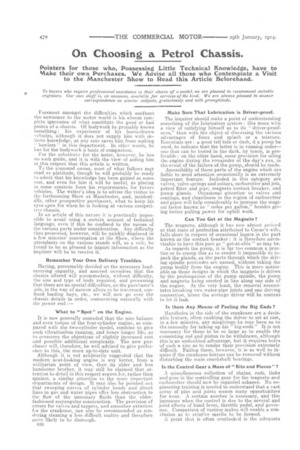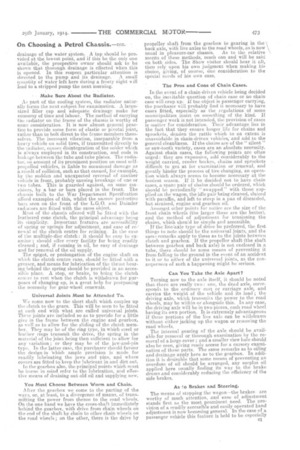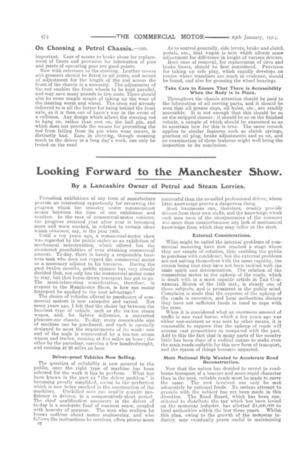On Choosing a Petrol Chassis.
Page 4

Page 5

Page 6

If you've noticed an error in this article please click here to report it so we can fix it.
Pointers for those who, Possessing Little Technical Knowledge, have to Make their own Purchases. We Advise all those who Contemplate a Visit to the Manchester Show to Read this Article Beforehand.
To buyers who require professional assistance in their choice of a model, we are pleased to 7 ecommend suitable ovineers. Our own staff is, on occasion, available for services of the kind. We are always pleased to answer
correspondence on simdal subjects, gratuitously and with promptitude.
Foremost amongst the difficulties which confront the newcomer to the motor world is his almost complete ignorance of what constitute the good or bad points of a chassis. Of bodywork he probably knows something : his experience of his horse-drawn vehicles, although it does not supply him with definite knowledge, at any rate saves him from making
• ' howlers " in this department. In other words, lie has for the bodywork a basis of comparison. For the substitute for the horse, however, he has no such guide, and it is with the view of aiding him in this respect that this article is written.
To the seasoned owner, most of what follows may read as platitude, through he will probably be ready to admit that his knowledge has been gained at some cost, and even for him it will be useful, as placing in some concrete form his requirements for future vehicles. The writer's idea is to advise the visitor to the forthcoming Show at Manchester, and, incidentally, other prospective purchasers, what to keep his eyes open for when he is looking at various competitive chassis.
In an article of this nature it is practically impossible to avoid using a certain amount of technical language, even if this be confined to the names of the various parts under consideration. Any difficulty thus presented, however, will be quickly displaced in a few minutes conversation at the Show, where the attendants on the various stands will, as a rule, be found to be as pleased to impart information as the inquirer will be to receive it.
Remember Your Own Delivery Troubles.
Having, presumably decided on the necessary loadcarrying capacity, and assured ourselves that the chassis offered will accommodate, without difficulty, the size and type of body required, and presuming that there are no special difficulties, on the purchaser's side, in the way of narrow alleys to be traversed, confined loading bays, etc., we will now go over the chassis details in order, commencing naturally with the power end :— What to " Spot " on the Engine.
It is now generally conceded that the nice balance and even torque of the four-cylinder engine, as compared with the two-cylinder model, combine to give such vibrationless running, and hence longer life, as to overcome the objections of slightly increased cost and possible additional complexity. The new purchaser will, therefore, be well advised to give preference to this, the more up-to-date unit.
Although it is not arbitrarily suggested that the modern neat-looking engine is any better, from a utilitarian point of view, than its older and less handsome brother, it may still be claimed that attention to detail in this respect argues for, rather than against, a similar attention to the more important departments of design. It may also be pointed out that sweeping curves of cylinder heads and direct lines in gas and water pipes offer less obstruction to the flow of the necessary fluids than the olderfashioned rectangular construction. The provision of covers for valves and tappets, and smoother exteriors for the crankcase, can also be recommended as rendering cleaning a less difficult matter and therefore more likely to be thorough.
B30
Make Sure That Lubrication is Driver-proof.
The inquirer should make a point of understanding something of the lubrication system : this more with a view of satisfying himself as to its " driver-proofness," than with the object of discussing the various advantages of force and splash or a mixture. Essentials are : a good tell-tale or dash, if a pump be used, to indicate that the latter is in running order— one that can be tested in the dark, by touch, is preferable: on the other hand, some provision for oiling the engine during the remainder of the day's run, in the event of the failure of the pump, should be made.
Accessibility of those parts of the engine which are liable to need attention occasionally is an extremely important feature. Included in this category are valves, valve springs and cotters, carburetter and jets, petrol filter and pipe, magneto contact breaker, and pump glands. Occasional attention to valves and seatings, and cleanliness in the region of carburetter and pipes will help considerably to increase the. magical factor known as " miles per gallon," besides giving better pulling power for uphill work.
Can You Get at the Magneto ?
The magneto, although it has now almost arrived at that state of perfection attributed to Ciesar's wife, falls short in respect of occasional lapses in the part known as the contact breaker : it is therefore advisvisable to have this part as " get-at-able " as may be.
As regards the pump, it is far too common a practice so to cramp this as to render it impossible to repack the glands, as the parts through which the driving spindle protrudes are named, without taking the pump bodily from the engine. This is more noticeable on those designs in which the magneto is driven by the prolongation of the pump spindle, the pump and magneto being erected in line along one side of the engine. At the very least, the removal necessitates breaking two water-pipe joints and one driving connection, hence the average driver will be content to let. it leak.
Is there Any Means of Feeling the Big Ends ?
Handholes in the side of the crankcase are a desirable feature, often enabling the driver to set at rest, in a few minutes, any misgivings he may have as to the necessity for taking up Ins " big-ends." It is not necessary for these to be so large as to enable the connecting rod and piston to be withdrawn, although this is an undoubted advantage, but it requires holes of such a size as to render their provision extremely difficult. Failing these, however, it is as well to inquire if the crankcase bottom can be removed without disturbing the main crankshaft bearings.
• Is the Control Gear a Mass of "Bits and Pieces" ?
A miscellaneous collection of chains; rods, links and pins in the controlling gear for the magneto and carburetter should now be regarded askance. No engineering training is needed to understand that a vast array of pins and joints means many opportunities for wear. A certain number is necessary, and this increases when the control is due to the several and joint efforts of hand lever, throttle pedal, and goveinor. Comparison of various makes will enable a con. elusion as to relative merits to be formed.
A point that is often overlooked. is the adequate
drainage of the water system.. A tap should be pro, vided at the lowest peat, and if this be the only one available, the prospective owner should askto be shown that thorough drainage is effected when this is opened. In this respect particular attention is directed to the pump and its drainage. A small quantity of water left here during a frosty night will lead to a stripped pump the next morning.
• • -Malie Sure About the Radiator.
As part of the cooling system, the radiator natur ally forms the next subject for examination. • A largesized filler cap and 'adequate drainage make for economy of time and labour. • The method of carrying the radiator oh the frame of the chasais.iis worthy of some consideration. It is now almost general practice to provide some form of elastic or pivotal joint; rather than to bolt direct to the frame members themselves,-The incessant vibration, inseparable from a heavy vehicle on solid tires, if transmitted directly to the radiator, causes disintegration of the solder which is always employed in its construction, and ends in leakage between the tube and tube plates. The radiator, on account of its prominent position on most selfpropelled vehicles, is liable to occasional damage as a resat of collision, such as that caused, for example, by the sudden and unexpected reversal or another vehicle in front, probably causing breakage of one or two tubes. This is guarded against, on some ma• chines, by a bar or bars placed in the front. The chassis built to the War Department Specification afford examples of this, whilst the narrow protective bars seen on the front of the L.G.O. and Daimler radiators are fitted with the same object.
Most of the chassis offered will be fitted with the leathered cone clutch, the principal advantage being its simplicity. Important features are accessibility of -spring or 'springs for -adjnstinent! and -case of re-new alof the clutch centre for relining. In the case of the multiple-disc clutch : it should ha easy to examine ; should offer every facility for being readily cleaned ; and, if running in oil, be easy of drainage and for'renewal of the oil supply.
The spigot, or prolongation of the engine shaft on which the clutch centre runs, should be fitted with a greaser, and means for lubrication of the thrust bearing behind the spring should be provided in an accessible place. A stop, or brake, to bring the clutch centre to rest when the clutch is withdrawn for purposes of changing .up, is a great help for postponing the necessity for gear-wheel renewals.
Universal Joints Must be Attended To.
We come now to the short shaft which couples up the clutch to the gears. This will be seen to be fitted at each end with what are called universal joints, These joints are included so as to provide for a little give in the frame between the engine and gearbox, as well as to allow for the sliding of the clutch member. They may be of the ring type, in which steel or leather rings transmit the drive, the spring in the material of the joint being then sufficient to allow for any variation ; or they may be of the jaw-and-pin type. In the latter ease, the purchaser should favour the design in Which ample provision is made for readily lubricating the jaws and pins, and where covers are fitted to keep the lubricant in and dirt out. In the gearbox also, the principal points which must be borne in mind refer to the lubrication, and effective means of draining out old oil and supplying new, You Must Choose Between Worm and Chain.
After the gearbox we come to the parting of the ways, or, at least, to a divergence of means, of transmitting the power from thence to the road wheels. On the one hand we have the cross-shaft immediately behind the gearbox, with drive from chain wheels on the end of the shaft by chain to other chain wheels on the road wheels ; on the other, there is the drive by propeller shaft from the gearbox to gearing in the back axle, with live axles to the road wheels, as is now \
usual in pleasure-car chassis. As to the relative s merits of these methods, much can and will be said on both sides. The Show visitor should hear it all, then rely upon his own judgment when making his choice, giving, of course, due consideration to the special needs of his osvn case.
The Pros and Cons of Chain Cases.
In the event of a chain-driven vehicle being decided -on, the inevitable question of chain case or no chain case will crop up: If tne object is passenger carrying, the piarchaser will probably find it necessary to have cases fitted, especially as the regulations of some municipalities insist on something of the kind. If passenger work is not intended, the provision of cases is matter for consideration. .Their advantage lies in the fact that they ensure longer life for chains and sprockets, deaden the rattle which to an extent is unavoidable in chain-driven vehicles; and add to the general cleanliness. If the chains are of the " silent " or saw-tooth variety, cases are an absolute necessity. Against chain cases, the following points are often urged : they are expensive, add considerably to the weight carried, render brakes, chains and sprockets difficult to get at for examination or renewal, and greatly hinder the process of tire changing, an operation which always seems to become necessary at the busiest season. If it be decided not to have chain cases, a spare-pair of chains should be ordered, which should be periodically " swapped" with those supplied on the wagon, the idle pair being cleaned, sluiced with paraffin, and left to steep in a pan of discarded, but strained, engine and gearbox oil.
Amongst other points for notice are the size of the front chain wheels (the larger these are the better), and the method of adjustment for tensioning the chains, which should be simple and accessible. If tha liVe:aXle 'type of. drive he preferred, the first things to note should be the universal joints, and the sanle remarks apply to these as to the joints between clutch and gearbox. If the propeller shaft (the shaft between gearbox and back axle) is not enclosed in a tube, there should be some means of preventing it from falling to the ground in the event of an accident to it or to either of the universal joints, as the consequences of such a happening might be serious.
Can You Take the Axle Apart?
Turning now to the axle itself, it should be noted that there are really two : one, the dead axle, corresponds to the ordinary cart or carriage axle, and carries the weight of the vehicle and its load ; the driving axle, which transmits the power to the road wheels, may be within or alongside this. In any ease, the driving axle will be in two pieces, each road wheel having its own portion. It is extremely advantageous if these portions of the live axle can be withdrawn without either jacking up the wagon or removing the road wheels, The internal gearing of the axle should he available for removal or thorough examination by the removal of a large cover ; and a smaller view hole should also be seen, giving ready access for a cursory examination of these parts. The same remarks as to oiling and drainage apply here as to the gearbox. In addition it is desirable that sonic means of preventing an overdose of oil should be arranged, any surplus oil applied here usually finding its way to the brake drums and considerably reducing the efficiency of the side brakes.
As to Brakes and Steering.
The means of stopping the wagon—the brakes-are worthy of much attention, and ease of adjustment stands first as the most prominent need. The provision of a readily accessible and easily operated hand adjustment is now becoming general. In the case of a passenger vehicle this featureis held to be especially
important. Ease of access to brake shoes for replacement of liners and provision for lubrication of pins and joints of operating gear are good points.
Now with reference to the steering. Leather covers and greasers should be fitted to all joints, and means of adjustment for the length of the rod across the front of the chassis is a necessity. The adjustment of the rod enables the front wheels to be kept parallel, and may save many pounds in tire costs. There should also be some simple means of taking up the wear of the steering worm and wheel. The cross rod already referred to is all the better for being behind the front axle, as it is then out of harm's way in the event of a collision. Any design which allows the steering rod to hang on, rather than rest on, the ball pin, and which does not provide the means for preventing the rod from falling from its pin when wear occurs, is distinctly bad. Ease in steering, though meaning much to the driver in a long day's work, can only be tested on the road. As to control generally, side levers, brake and clutch pedals, etc., that wagon is best which affords some adjustment for difference in height of various drivers.
Here ease of removal, for replacement of tires and brake liners, should be first considered. Provision for taking up side play, which rapidly develops on routes where tramlines are much in evidence, should be found, and also for greasing the wheel bearings.
Take Care to Ensure That There is Accessibility When the Body is in Plate.
Throughout the chassis attention should be paid to the-lubrication of all moving parts, and it should be seen that all grease cups, oil holes, etc., are readily accessible. It is not enough that this should be so on the stripped chassis : it should be so on the finished vehicle, a sample of which should be examined so as to ascertain how far this is true. The same remark applies to similar features such as clutch springs, gearbox oil plug, brake adjustments and so on, and an examination of these features might well bring the inspection to its conclusion.






































